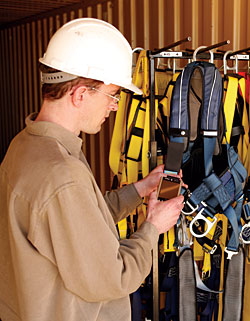Harnessing the Technology
This RFID-based system is designed as a lifeline for safety directors.
 HARNESSES,
lifelines, and other fall protection components are only as good as the
life they have in them. One U.S. company is trying to add to that
truism by showing safety directors that such equipment may only be as
good as the RFID tags it has in it--tags that, when read by a handheld
PDA, tell them something about the gear's life, including when it was last inspected, its assignment history, and other information.
HARNESSES,
lifelines, and other fall protection components are only as good as the
life they have in them. One U.S. company is trying to add to that
truism by showing safety directors that such equipment may only be as
good as the RFID tags it has in it--tags that, when read by a handheld
PDA, tell them something about the gear's life, including when it was last inspected, its assignment history, and other information.
The company is Capital Safety of Red Wing, Minn. The system is
called i-Safe™, and how it works is this: Passive RFID (radio frequency
identification) tags, or transponders, programmed with a unique ID that
registers model type and history are embedded in or attached to each
piece of the company's fall protection gear; a portable PDA reader
scans the tags in the gear on site, logging inspections and equipment
assignments by worker or location with one click; this data is then
linked to a customized Web portal hosted on the Capital Safety site (www.capitalsafety.com).
The portal, which is available to i-Safe users at no cost and password
protected to individual companies, provides instant access to
inspection and training records on a scanned piece of equipment, plus
any product advisories, official regulations, and related safety
information.
Capital Safety began beta-testing the system with select companies
earlier this year and says response has been enthusiastic. The
insulated, weather-resistant RFID tags are already standard in all of
its new DBI-SALA-brand harnesses, and, according to Bill Schultz,
global vice president of marketing, all other DBI-SALA
products--lanyards, lifelines, and even hard goods--will include the
tags by the end of the year.
"This system is bringing fall protection into the information age,"
Schultz said. "The feedback we're getting really falls back on what
we're calling the three I's of the system--inspections, inventory, and
information. Users are saying, 'This now easily gives me the ability to
control my inspections; it systematically takes me through the criteria
by which all fall protection products are inspected consistently, time
after time, regardless of who's conducting that inspection, and at the
same time, it's giving me real-time access to my records.'
"Before, OSHA would show up and say, 'Let me check your inspection
logs on your harnesses,' for example, and, without this technology, it
could be rather challenging to do that. In a big construction project,
a big stadium project, you're dealing with literally hundreds of
harnesses. That's where the benefits of this system really come into
play, because now safety directors can comply with the requests and do
it in a real-time mode. They simply go back into the portal and say,
'Please print out my inspection list for all products on, say, Site
21,' and it's done."
Schultz added that the system also makes equipment transfers among
sites easy to track and is reducing costs associated with last-minute
product assignments. He noted, however, that this feature tracks only
location, not motion or activity, and that the tags are not equipped
for use as GPS devices, which would add elements of complexity, cost,
and potential worker antipathy, all of which Capital Safety is avoiding.
Putting RFID in FP
Shaped like miniature doughnuts, the i-Safe tags are about the
size, weight, and thickness of two quarters. Capital Safety Vice
President of Information Technology Bruce Underwood said most users
will never even notice the tags, unless they have been integrated in
the equipment through the retrofit kit the company has made available.
The kit, sold for $5 each and comprised of a pouch with a one-time snap
and a tag that fits inside, makes the system work with any brand of
equipment.
"In terms of the type of equipment you're putting them on, these
tags are a pretty cost-effective solution to tracking the life of these
products," Underwood said. "But RFID is RFID, and a tag is a tag.
What's really unique about our solution is 1) the fact that it is
becoming standard on all of our products, and 2) now we have a mobile
software solution through the PDAs, so you can take i-Safe to the
construction site, the oil rig, or wherever and, while being in the
field, you're inspecting, assigning, checking the status of things with
this system. So the power of i-Safe isn't in the tag, it isn't in the
reader; it's actually in the software. The software is where the value
is. It's the software that will give you better compliance and better
inventory and inspection records literally by the press of a button."
Even with the information that button press facilitates, gear such
as harnesses must still be inspected with the eyes and hands prior to
every use. And it is a best practice to remember that the life of all
such gear is limited.
This column appeared in the October 2006 issue of Occupational Health & Safety.
This article originally appeared in the October 2006 issue of Occupational Health & Safety.